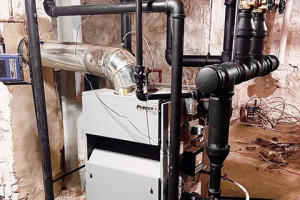
Hello, old friend. I’m writing today to say thanks, and to say farewell. This will be my last column.

A guy I don’t know emailed me a question. I get a lot of that because I’m easy to find on the internet. He wanted to know if it’s true that all manufacturers stopped making cast-iron radiators back in the 1950s when I was watching “Howdy Doody.” He heard they were no longer available and hadn’t been for a very long time.
I wrote back and told him that this was not true, and that manufacturers continue to make and sell cast-iron radiators. They also still make cast-iron baseboard radiators. I included a link to one of the manufacturers’ product catalogs to prove my point. Radiators are alive and well.
He wrote back saying that he thought it was true that all manufacturers stopped making them in the ‘50s and that I was mistaken.
I responded again — mainly because I’m retired with too much time on my hands — but I was also curious as to how he had come to this conclusion, and in spite of the facts I had sent him.
“My friend lives in Southern California,” he wrote. “He told me that there are no cast-iron radiators there and there haven’t been any there since the manufacturers stopped making them in the ‘50s. It’s true.”
I explained that it is mostly warm in Southern California and that this was probably why his friend wasn’t seeing any cast-iron radiators there. Weather has an effect on the heating market. The warmer it is, the fewer radiators there are.
“My friend said there are none,” he wrote back. “He lives there.”
“Tell your friend to go to San Francisco,” I wrote. “There are cast-iron radiators there, and San Francisco is in California. My brother lives in Oakland, right next to San Francisco. He has cast-iron radiators and steam heat in his apartment building.”
“My friend says there aren’t any,” he answered. “I’m wondering why they stopped making them. What happened?”
I decided I didn’t have that much time on my hands and stopped writing to him. But that guy stays with me because of his persistence. He was on a mission and it’s often difficult to talk to people on a mission. Their minds are closed. Your facts mean nothing to them.
And then there was this other guy who had also made up his mind. He didn’t write to me. He posted his question on The Wall at HeatingHelp.com. I thought I could help. I should have known better.
“I live on the top floor of a New York City apartment building. Our apartment has five vertical, floor-to-ceiling pipe heaters. It’s not that they don’t heat the apartment properly; it’s that they make unbearable whistling sounds. We just moved in a couple of weeks ago and these things have woken me up practically every night I’ve been here. The release vents on the pipes take 15 to 20 minutes to empty whatever air is inside the pipes, which seems kind of long. The vents on each of them are Hoffman #41, with holes for the pipes that are 1/8-inch wide. Is that big enough for this type of line? And are these the building’s main lines? I suspect they are, as the landlord has said if I were to turn one of the vents off, the resulting radiators connected to it would turn off as well. Also, would a building of this size have a one- or a multi-pipe heating system? That question, admittedly, is a little out in left field, but it’s a curiosity of mine.
“But anyway, I want to try out a larger air release valve, such as a Gorton #2, or a Hoffman #75. Does that make sense here? Do I run the risk of water spraying out of the ventilation hole if it’s too big? When I suggested to my superintendent that he widen the hole (not knowing what a main line valve was or what, generally, I was talking about at the time), he said that would cause 400-degree water to spray everywhere and that these valves all come in just one size. I assume he means 1/8-inch. I don’t know if what he said regarding the water was true (though I think he inflated the temperature a bit), but seeing as how I now know his second statement was false, coupled with the general impression I have of this guy, I get the feeling that he doesn’t have much experience. So I guess my final question is this: Is it OK and safe to buy and then try connecting one of those other vents on my own?”
What he has is a typical setup in New York City. The pipefitters ran steam risers from floor to ceiling in tenement kitchens and bathrooms. The pipe typically rose five or six stories and it was the radiator for that room. Its output was this:
1 1/4” riser = .63 sq. ft. EDR per linear vertical foot
1 1/2” riser = .73 sq. ft. EDR per linear vertical foot
2” riser = .88 sq. ft. EDR per linear vertical foot
(One sq. ft. EDR = 240 Btu/h in a steam system.)
There’s only one vent on these risers and it’s almost always in the top-floor apartment. These vents often whistle on startup because the pipefitter drilled the pipe for 1/8-inch rather than install a tee. That saved a couple of bucks back in the day.
To stop the whistling air that’s trying to get out through the too-small hole, top-floor tenants often turn the air vent upside down. That keeps the air from venting because the vent’s float and pin fall by gravity into the vent’s hole. That stops the noise because it stops the venting. But it also stops the heat to the entire riser because if the air can’t get out, the steam can’t get in. Everyone on that riser loses their heat because the guy on the top floor doesn’t like the noise.
After getting complaints from the lower-floor tenants, the super will investigate and turn the vent back upright. As soon as he leaves, the tenant will turn the vent back over again.
I wrote on The Wall to this guy, whom I do not know.
“The size of the hole in the pipe is going to determine how much air leaves the air vent, no matter what size the air vent is,” I explained. “Your vent is the air-release point for the entire six floors of pipe radiators. I think you need a pro with tools that can increase the size of the hole to accommodate a vent with the correct venting capacity. He’ll need to add a tee of the proper size to do this. I also think the steam pressure in the building is probably much too high. Tell your super the water can’t be hotter than 212° F, and that it won’t splash out if the velocity of the air escaping is slower, as it should be.”
He posted: “I think I’m going to try a big Gorton air vent. I see from their literature that they vent faster.”
I wrote again. “The size of the hole in the pipe is what determines the venting rate. Think of it as a highway with all but one lane closed. The width of the road after the bottleneck doesn’t speed traffic through the bottleneck. You can only force so much air through a 1/8-inch hole.”
He wrote back: “Given that it’s Hoffman #41s that are in there now, would I have to buy some big-to-small-like extension if I were to use a Gordon #2? It looks like the part that screws in on a Gordon #2 is a bit bigger than the part that screws in on a Hoffman #41. And if so, what is that big-to-small part called?”
One of the Wallies wrote (because I had given up at this point), “The Gorton #2 has a 1/2-inch pipe connection. You can try a 1/8- to 1/2-inch adapter, but I’m not sure how well that will allow condensate to drip out of the Gorton when the steam is cycling.”
I’m shaking my head and still thinking about traffic bottlenecks because I’m a native New Yorker and I have seen this situation so many times. He has a problem. I have a solution.
“OK, I’m going to get the Gortons,” he wrote.
He had made up his mind and facts meant nothing to him. Perhaps you’ve met this guy? His last name is Knucklehead.

Hello, old friend. I’m writing today to say thanks, and to say farewell. This will be my last column.

My six-year-old grandboy, Brendan, was in the vestibule of the diner when the bubblegum machine caught his attention. It was one of those spiral models that appeared in t...

Subdural posed a question on The Wall at HeatingHelp.com in the Strictly Steam section, where some of the sharpest knives in the drawer post every day. The question was a...